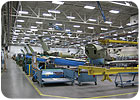Cessna Aircraft saved money by swapping its conventional lighting system for high-intensity fluorescent bulbs and fixtures.

Except when its stops working, few assemblers pay much attention to their plant’s lighting system. However, keeping the lights on represents a major cost of doing business, especially in this era of skyrocketing energy prices. A well-lit facility is also conducive to manufacturing efficiency and quality.
With these issues in mind, Cessna Aircraft Co. recently switched out its conventional high-intensity discharge (HID) lighting system with some 4,200 T8 high-intensity fluorescent (HIF) bulbs and fixtures from Orion Energy Systems (Manitowoc, WI). The results have been such a success that the company is now planning on using Orion Energy Systems’ fixtures and bulbs in a number of other plants as well.
“The new lights dramatically improved the appearance of the plant and everything in it,” says Cessna facility engineering and maintenance manager Tom Butherus. “We’ve received a lot of ‘thank yous’ from our employees who especially like the improved color rendition.”
According to Butherus, the new system has reduced the plant’s electrical consumption by some 4,875,000 kilowatt-hours per year, which translates into about $213,000 in savings at current electric rates. The company is also saving an additional $9,000 in reduced air-cooling costs, due to the fact that Orion’s HIF bulbs generate far less heat than the HID bulbs Cessna used previously.
Environmentally, the changeover has allowed Cessna to reduce its corporate carbon footprint by about 4,700 tons annually. The company is also reducing sulfur dioxide emissions by about 21 tons per year and nitrogen oxide emissions by about 10 tons per year.
Stated another way, by switching over its lighting system Cessna’s reduced power usage is equivalent to removing 783 cars from the road and burning about 400,000 gallons less gasoline annually.
Founded in 2001, Orion has installed its lighting systems in approximately 3,700 facilities in North America. Its products now displace about 357 megawatts of power and save its customers a combined $402 million each year. Collectively, Orion’s products are cutting annual indirect carbon dioxide emissions by about 3.6 million tons.
According to Butherus, “The positive environmental impact is consistent with the goals of the Cessna Environmental Council… The economics just make good business sense… We cut our electricity costs for lighting very significantly.”
For more information on lighting systems, call 877-204-6852 or visitwww.oriones.com.



